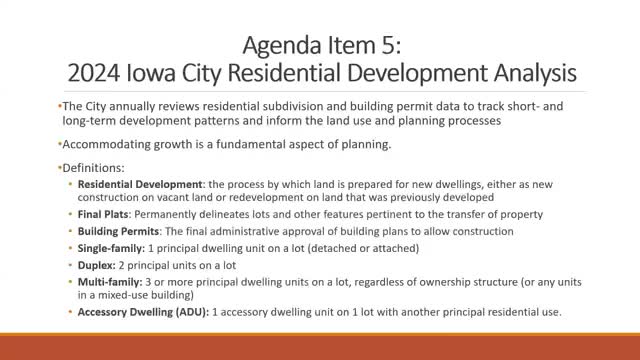City Council reports significant drop in residential development and permits for 2024
June 06, 2025 | Iowa City, Johnson County, Iowa
This article was created by AI summarizing key points discussed. AI makes mistakes, so for full details and context, please refer to the video of the full meeting. Please report any errors so we can fix them. Report an error »

The Iowa City Planning and Zoning Commission convened on June 4, 2025, to discuss critical developments in residential planning and zoning, revealing significant trends and challenges in the local housing market. The meeting highlighted a notable decline in subdivision activity and building permits, raising concerns about the city's ability to meet future housing demands.
Key discussions centered around the 2024 residential analysis, which indicated a sharp drop in subdivision activity, particularly in single-family lots, which fell 75% below the five-year average. The report noted that no new attached single-family or duplex lots were platted in the past year, and overall building permits were less than half of the ten-year average. This decline in new housing developments is particularly concerning given the city's projected housing shortage, with estimates suggesting that only 68% of the demand for new housing will be met by 2030, resulting in a deficit of approximately 14,000 dwelling units.
The commission also examined the impact of recent trends in the university impact area, where the lack of multi-family developments has contributed to lower overall housing activity. While the number of buildable vacant lots increased due to new infrastructure and revised counting methods, the anticipated build-out time for these lots has extended, indicating a slower pace of development.
In terms of permitting, the commission reported that 145 units were permitted in 2024, which, while slightly better than five-year trends for single-family homes, still represented a decade low for multi-family units. The meeting underscored the importance of final plat activity as a leading indicator for future residential development, with only six final plots approved in 2024, primarily for small single-family infill lots.
The discussions also touched on the potential for market fluctuations as older residents move into new developments, potentially freeing up properties for younger families. However, the analysis did not account for the dynamics of these transitions, leaving some uncertainty about the overall impact on housing availability.
In conclusion, the Iowa City Planning and Zoning Commission's meeting highlighted pressing issues in residential development, including declining permit activity and a growing housing shortage. As the city grapples with these challenges, the need for strategic planning and proactive measures to stimulate housing development will be crucial in addressing the community's future needs. The commission's next steps will likely involve further analysis of permitting trends and potential policy adjustments to encourage more robust residential growth.
Key discussions centered around the 2024 residential analysis, which indicated a sharp drop in subdivision activity, particularly in single-family lots, which fell 75% below the five-year average. The report noted that no new attached single-family or duplex lots were platted in the past year, and overall building permits were less than half of the ten-year average. This decline in new housing developments is particularly concerning given the city's projected housing shortage, with estimates suggesting that only 68% of the demand for new housing will be met by 2030, resulting in a deficit of approximately 14,000 dwelling units.
The commission also examined the impact of recent trends in the university impact area, where the lack of multi-family developments has contributed to lower overall housing activity. While the number of buildable vacant lots increased due to new infrastructure and revised counting methods, the anticipated build-out time for these lots has extended, indicating a slower pace of development.
In terms of permitting, the commission reported that 145 units were permitted in 2024, which, while slightly better than five-year trends for single-family homes, still represented a decade low for multi-family units. The meeting underscored the importance of final plat activity as a leading indicator for future residential development, with only six final plots approved in 2024, primarily for small single-family infill lots.
The discussions also touched on the potential for market fluctuations as older residents move into new developments, potentially freeing up properties for younger families. However, the analysis did not account for the dynamics of these transitions, leaving some uncertainty about the overall impact on housing availability.
In conclusion, the Iowa City Planning and Zoning Commission's meeting highlighted pressing issues in residential development, including declining permit activity and a growing housing shortage. As the city grapples with these challenges, the need for strategic planning and proactive measures to stimulate housing development will be crucial in addressing the community's future needs. The commission's next steps will likely involve further analysis of permitting trends and potential policy adjustments to encourage more robust residential growth.
View full meeting
This article is based on a recent meeting—watch the full video and explore the complete transcript for deeper insights into the discussion.
View full meeting
